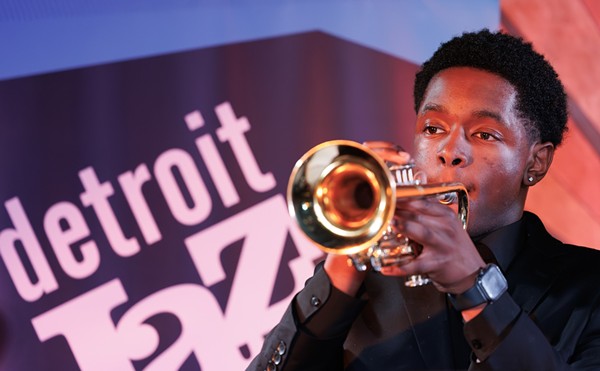Detroiter Roy Brooks was a spectacular musician — a musician who often reminded audiences that the root of spectacular is spectacle. He drove bands — those of Horace Silver-level stars or his own — from his drum kit, lashing his trademark percussive patterns onto the skins and metal. His creativity, though, demanded far different outlets. He came to the front of the bandstand to solo on musical saws, steel drums, thumb pianos and other instruments. He put on one-man multi-media shows and performances with wind-up musical toys. He founded a percussion choir that, at times, spotlighted tap dancers, stilt walkers and basketball players. News that Brooks was playing always elicited a question: What will Roy be doing this time?
But he was also a troubled soul, beset with bipolar disorder. Tales of erratic and sometimes frightening behavior were legend.
His imprisonment in 2000 following armed threats against his neighbors — once with an unloaded shotgun, again with a bullwhip and a machete — carried a sad inevitability after a downward spiral in the ’90s. That Brooks really needed treatment, not prison, was repeated incessantly among his fellow musicians and fans.
While in a series of Michigan prisons his health precipitously declined. Dependent on a wheelchair when he was released to a nursing home in 2004, he never regained his mobility or returned to playing. This summer his legs were amputated because of circulation problems. Last week — on Tuesday, Nov. 15 — he finally died after suffering ailments from cardiovascular problems to arthritis.
Fellow percussionist Francisco Mora worked with Brooks in Detroit projects including Brooks’ Aboriginal Percussion Choir. He also traveled extensively as a peer in drummer Max Roach’s percussion group M’Boom, and got to see the best and the worst of Brooks. He talks with a sense of amazement at the things Brooks had done given the odds against him.
“He is an example of African-American creativity under the most severe oppression, under the most severe obstacles, he was black and he had a mental condition.”
“I think it was heroic,” Mora says.
Brooks came of age during a golden age of Detroit jazz. The Bluebird Inn at Tireman and Beechwood was one of the hottest spots in the 1950s. The late drummer Elvin Jones, famous for his work with John Coltrane’s quartet, in one interview recalled that part of that scene was a coterie of underage drummers like Roy Brooks, who would stand outside at night and ask Jones to raise the blinds to the window by the bandstand so they could watch. By day at Northwestern High, Brooks regaled classmates like future writer Herb Boyd with tales of late-night jams and dissections of the traits of the top drummers of the day. Wrote Boyd: “And he would sit there with a devilish grin, living up to his claim as class clown, his bowtie and neatly coiffed Quo Vadis haircut framing his ebony face.”
Soon after graduation he was hitting the road with saxophonist Yusef Lateef; at 21, he took the drum seat in the Horace Silver Quintet, one of the top jobs in jazz. After several years with Silver he went on to play and record with other top artists, such as Charles Mingus, Dollar Brand, Chet Baker, Pharoah Sanders, Dexter Gordon and Randy Weston.
He eventually established a long-term relationship with Roach’s M’Boom group and started his own ultra-hard-bopping outfit, the Artistic Truth. He continued with both groups after he returned to Detroit in the mid-’70s when his mother became ill. Detroit became his new base.
“We learned a lot from Roy,” says saxophonist Wendell Harrison, who played in some of the Artistic Truth lineups and later played alongside Brooks in the Michigan Jazz Masters group.
“Every time Roy performed, it had a meaning to his future,” Harrison continues. “A lot of guys just hit for the sake of hitting. When he hit, he would have a theme, he was making history. And to get on the stage, you had to mean something to his way of thinking.”
Mora emphasizes that Brooks built on the works of others such as Max Roach with his percussion choirs and solo shows.
Still, Mora says, “What Roy did was very distinctive and different.”
Brooks was so distinctive as to invent his own instrument: He adapted his tom-tom drums with what he called the breath-o-tone, tubing that he blew into to temporarily inflate the drum head, allowing him to raise and lower its tone while he played. Likewise he sought out and promoted young musicians such as pianist Geri Allen.
But there was always an undertow from Brooks’ churning mind. In a Metro Times article about Brooks’ travails, writer Jim Dulzo discussed how Brooks’ wife, Hermine, slowly became aware of his problems after they married in 1967. One morning she recalled waking to find her husband carrying on in the kitchen to Thelonious Monk and the ultimate jazz scenester, Baroness Pannonica de Koenigswarter.
“Nobody was talking but Roy. And Monk was, like, with his eyes wide open, saying, ‘This man is crazier than me,’” Hermine Brooks said.
Brooks was sometimes institutionalized. He had a catch-22 with medication in that drugs that stilled his mind sometimes dulled his playing. Hermine Brooks, who moved to Detroit to be with her husband, said she eventually gave up on being able to help him and returned to New York. (Brooks is survived by Hermine and sons Raheem Brooks and Richard Pinkston.)
At least one mental health official familiar with his case has called it a sad example of Michigan’s inability to cope with people who need long-term psychiatric care.
Over the years the stories of Brooks being verbally abusive or physically threatening were whispered legends, including an incident involving a naked, knife-wielding Brooks chasing pianist Barry Harris down the street.
Mora recalls one time he went backstage to greet Brooks. “I went to embrace him, I bent down to give him a hug and he punched me out of the blue,” Mora says. He suspects it was a fit of jealousy over the woman that Mora was with. But, he says, “I would never know what was on his mind.”
And no one else, apparently, really knew either, except for the music.
Update: Fellow musicians, assorted artists, family, fans and friends, upwards of 200 of them, overflowed the sanctuary at the Swanson Funeral Home’s McNichols chapel in Detroit to say farewell to Roy Brooks on Tuesday, Nov. 22.
They recalled the genius of his music, laughed about his antics, talked of how he’d changed their lives and held up his uniqueness as a model. To be yourself, someone said, is the way "to keep Roy alive."
The bassist Rod Hicks put Brooks’ high-school basketball skills on the same plane with the Harlem Globetrotters, and imitated Brooks’ walk, a sort of swaggering, stylized galumph. The percussionist Clifford Sykes played Brooks’ saw in the style Brooks invented, standing, with a mallet rather than the traditional bow. And community activist Njia Kai reminded everyone that Brooks was crazy in the best and saddest senses of the word.
U.S. Rep. John Conyers noted the other similar events he’d been to in recent months, for the late Detroit bandleader Teddy Harris and the singer Shirley Horn. "The circle of originators gets smaller and smaller, what’s left behind gets larger and larger," Conyers said, of their legacy. Yusef Lateef sent a poem for the occasion.
There was music, of course. The tap dancer Flash Beaver imitated Louis Armstrong’s growl for "What a Wonderful World." Singer Shahida Nurullah sang "My One and Only Love," someone else sang "Swing Low, Sweet Chariot." Spencer Barefield played his composition "Ghost Dance" in tribute.
And just before the benediction, pianist Geri Allen — who spoke of how much Brooks meant to her generation of musicians — led the band in Brooks’ tune "The Smart Set."
Leonard King set a snare drum head on his lap and snapped the rhythm with brushes while a retinue of other drummers and percussionists joined in. Trumpeters Marcus Belgrave and Rayce Biggs soared; Vincent Bowens and Alan Barnes were among the saxophonists on hand for the funky, driving tune. Beaver did his best tap moves — inaudible, though, on the carpeted floor.
Eventually Sykes took the microphone and sang the tune as recorded years ago by the late Eddie Jefferson — another Brooks associate — extolling the virtues of hipdom.
"Send him home, send him home," cried the poet and painter Aaron Ibn Pori Pitts, referring to Brooks’ spiritual journey. And when the jam ended, the organist Gerard Gibbs bounced up from his seat, thrust a hand into the air, and shouted, "Only in Detroit."
W. Kim Heron is Metro Times managing editor. Send comments to [email protected]





